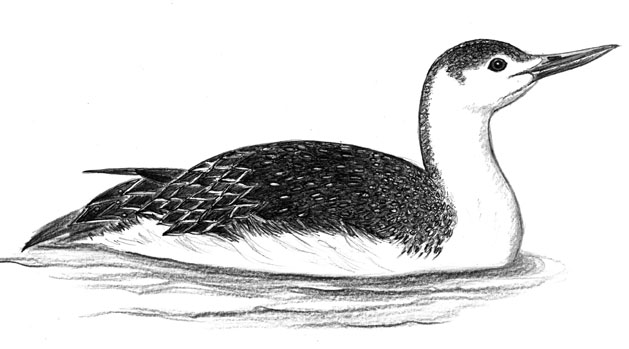
Dear Bird Folks,
I’ve always wanted to photograph a Common Loon, so last week when I heard there were several just off Marconi Beach (Wellfleet, MA), I grabbed my camera and headed off to find them. It didn’t take long to locate the birds, but I was disappointed when I discovered the loons were in their dull winter plumage. (See attached photo.) When do you think these loons will be in their gorgeous breeding plumage again?
– Ryan, Sandwich, MA
It gets worse, Ryan,
If you were “disappointed” when the loons you saw were a little dull-looking, you’d better get ready for even more disappointment. The birds in your photo (take a deep breath) aren’t even Common Loons. Sorry, bro. Pictures don’t lie (except for the one on my driver’s license – there’s no way that’s me). The birds in your photo are Red-throated Loons, the smaller cousins of Common Loons. Don’t worry about not identifying the loons correctly. The two birds are similar. Besides, you probably have a lot on your mind right now. Christmas is coming up, Duchess Kate is having a baby, and there’s the fiscal cliff thing. Anyone could misidentify a loon with a fiscal cliff looming. I know it has me worried, and I’d be even more concerned about it if I knew what it was.
This may be your first experience with Red-throated Loons, Ryan, but they are actually more numerous around the waters of Cape Cod than most people think. And in some months they are darn right abundant. In the late fall, for example, they can easily be seen from just about any beach. However, the number of loons is not nearly high as the number of dog walkers on the beach. There is no number that high.
I don’t know if you read the local papers, but a few weeks ago a Red-throated Loon smashed through the windshield of Cape Air flight that was headed to Nantucket. (The plane landed safely, but they made the loon buy a ticket…at full price.) Fortunately, incidents such as that are rare. For the most part, loons cause very little trouble. In fact, Red-throated Loons are huggers, big-time huggers. But they aren’t the kind of huggers that make everyone else uncomfortable. They are coastline huggers. At the end of each summer they leave the freshwater lakes of northern Canada and head for the coast. There the loons will spend the winter just offshore, where beach walkers can easily see them. Well, the beach walkers can easily see them if they aren’t too busy watching where they step.
In the summer Red-throated Loons are unmistakable. The have dapper gray heads and necks, which are trimmed with fine pinstripes, making them look like ushers at a British wedding. But the key field mark of the Red-throated Loon is, of course, the red throat. The signature red is not only a good field mark, but it matches the bird’s bright red eyes. (I know seeing a bird with a red throat and bright red eyes sounds like a sign of the devil, but it actually works for them.) Unfortunately for you, me and everyone else who lives along the coast, Red-throated Loons (as well as your pals, the Common Loons) lose these handsome colors by time they arrive here in the fall. This makes identification a little more difficult (and a lot less fun). But with a little practice and a few hints, you should be able to tell which loon is which.
The first notable difference between these two loons is their size. Common Loons are huge birds, about three times heavier than red-throats. In sports terms, Common Loons look like fullbacks, while red-throats look like gymnasts. Red-throats are actually the more agile of the two. They don’t need the embarrassingly long, splashing takeoffs that Common Loons require. Plumage-wise, both birds are dull in the winter, but Common Loons tend to be dingy-brown while red-throats are grayer. It’s also important to pay attention to the shape of the birds’ bills. Red-throats have sleeker, more delicate bills, while Common Loons have thick, heavy-duty bills, looking like something used to crack open a safe. But the most helpful field mark is the way Red-throated Loons hold their beaks. As the bird swims it looks is if its thin bill is slanting upward. It reminds me of FDR clinching a cigarette holder in his teeth. (That last hint may not be helpful to everyone, but it works fine for old people like me.)
Another difference between the two loons is their voices. Common Loons have that classic, haunting loon yodel. Even people who don’t know birds are familiar with this sound. That’s because the goofballs in Hollywood incorporate loon calls in movie tracks. Loons can be heard in just about every outdoor scene, including ones set in the jungle or the desert, or in other places loons would never be. The harsh voice of the Red-throated Loon, on the other hand, is more annoying than classic. It sounds like a Herring Gull with its foot stuck in a car door. I don’t know if the goofballs in Hollywood use Red-throated Loon calls in horror movies, but they should.
The molting process for loons is complicated and poorly understood. But it’s a safe bet, Ryan, that you’ll have better luck photographing loons in their “gorgeous breeding plumage” if you wait until early spring. (Don’t worry; they’ll still be around then.) I’m really looking forward to spring. It’s not that I don’t like winter, but if I’m still here in the spring it will mean that I’ve survived the dreaded fiscal cliff. Maybe by then I’ll even know what it is.